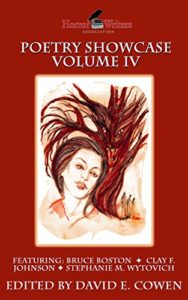Today, by request (thanks, Jay Lemming!), I’m going to give my review of the move It. But first, I’d like to draw your attention to my three newest treats:
 First, if you haven’t already, I really hope you’ll go read my story “So Sings the Siren” in Apex Magazine Issue 101. It’s free on their website now, and at just over 1,000 words is a quick read. It does come with a trigger warning; it’s not for the faint of heart, but it’s horror that means something. And Apex picking it up means a lot to me, as does this story itself. It’s straight from my dark little heart. So if you enjoy it, please share it with anyone you know who might enjoy it too. <3
First, if you haven’t already, I really hope you’ll go read my story “So Sings the Siren” in Apex Magazine Issue 101. It’s free on their website now, and at just over 1,000 words is a quick read. It does come with a trigger warning; it’s not for the faint of heart, but it’s horror that means something. And Apex picking it up means a lot to me, as does this story itself. It’s straight from my dark little heart. So if you enjoy it, please share it with anyone you know who might enjoy it too. <3
 Second, this year’s edition of the Horror Writers Association Poetry Showcase—Volume IV—is out now! I’m pleased to have a poem in this one for the fourth consecutive year. “Unravel” is an unsettling horror love poem. Yes, you read that right. 😉 You can order a copy of this year’s showcase in paperback for $7.99 or as an ebook for $2.99. This is also one of the potential prizes included in this year’s #BooksBrewBoo! (Which is still going on, by the way! Commenting on this post enters you to win, as do all of the helpful options at the bottom of this post. Entries have slowed down mid-month, so please share if you can; you have a good chance of winning!)
Second, this year’s edition of the Horror Writers Association Poetry Showcase—Volume IV—is out now! I’m pleased to have a poem in this one for the fourth consecutive year. “Unravel” is an unsettling horror love poem. Yes, you read that right. 😉 You can order a copy of this year’s showcase in paperback for $7.99 or as an ebook for $2.99. This is also one of the potential prizes included in this year’s #BooksBrewBoo! (Which is still going on, by the way! Commenting on this post enters you to win, as do all of the helpful options at the bottom of this post. Entries have slowed down mid-month, so please share if you can; you have a good chance of winning!)
Third, my next LitReactor post is out today, so be sure to check out “13 Halloween Themed Anthologies to Fill Your Season with Fright.” (Note: this is also an eligible entry for #BooksBrewBoo.)
Okay, on to It!
What did I think of the movie It? I was disappointed. I thought it had a lot going for it: fantastic acting by the children, beautiful production value, and a powerful nostalgia factor. It was charming to see the kids interact, and refreshing to hear them curse like kids really do. If it had been its own creation and not a movie with source material and a previous version, I might’ve liked it a lot. Unfortunately, those are the facts of this film.
One of my most popular blog posts ever has been this one: “Thoughts on IT by Stephen King, What it Takes to Enjoy Horror, and Why I Write It.” In it I talk about that infamous novel and why I love it despite its flaws: it’s truly scary. The biggest reason I love King is his understanding of fear. Creating fear in readers means understanding its sources, not just what’s scary, but why. In my opinion, King is the master of that. It serves as a case in point: it’s the only novel to give me a nightmare as an adult. That’s powerful stuff.
Modern horror movies are a mixed bag—as are all movies in every time period—but one thing they widely have down incredibly well is the fear factor. Is it a deep-seated, insidious fear that sticks with us the way the best horror novels do? Very rarely. Still, it’s incredibly effective in the moment. I feel unnerved, tense, scared, or outright terrified at at least half of the horror movies I bother seeing in theater these days. (Which, admittedly, weeds out the ones so obviously bad I don’t bother.)
So It, a movie based on one of the scariest novels of all time, made during the height of scary movie techniques, was poised to be a homerun, right?
Not for me. I was never scared during the movie. Not once. Not even a little. And you guys, I scare easy. Given the promises of Pennywise and Co., to me that’s a pretty serious fail. I don’t even know how they managed to do it. How did such a high budget, well-made production like this fail on its obvious primary objective?
I’m not a movie-maker, so there are probably subtleties I missed, but I can tell you that from a horror creator’s perspective, they didn’t understand their fear-maker. Pennywise is insidious in the books because he gets to the root of each kid’s fears. He sneaks, he slithers, he stalks. He doesn’t show his face much. That makes him scarier, because it makes him unknown. We’re afraid of the unknown; we project our worst fears into it. King understood that. The movie doesn’t.
Pennywise in this film gets almost as much air time as the actual kids. He’s there all the time. Jeeze, P, give us a chance to miss you. Although visually gorgeous in a photoshoot way, Pennywise’s costuming is way off the mark here. Clowns are inherently creepy because they fall into the uncanny valley. They’re supposed to look happy but they don’t quite. They unnerve us because we almost see the person beneath the grotesquely exaggerated makeup. We want to focus on their jovial demeanor but the unknown (ah, see there?) person beneath keeps peering through the façade. A stranger. Dangerous.
But It’s Pennywise looks like he could only be in a horror movie. Even a kid as young as Georgie would know on sight that this is an evil, scary thing. If that’s chasing you down the street you might—might—have an argument for overt creepiness being more effective. But if that’s luring you into a storm drain, it’s no contest: subtle wins. If it’s subtle, you can understand why a kid might fall for it. If you understand, it means you can imagine it. If you can imagine it, it means it could happen to you. Fear.


Back to back you can really see the difference. The first is from the original movie, of course, and not the book, but it’s one thing the original got right in a big way.
I have lots of nitpicks of the movie, but my post can only go on so long. The main issue for me is the fear factor. The other is the overall tone. I know they were trying to cash in on Stranger Things’ nostalgia boom with the feel-good childhood mojo and shifting the original 50’s setting into the 80’s, but for me they leaned too heavily into that happy sweet side of things. I love a goodhearted movie, but not when the book has such a dark heart. A little nostalgia sugar would’ve been enough. And although I’m glad they changed that unsuccessful and highly disturbing sewer orgy, I don’t think a literal group hug was the way to do it. (And that’s not a sentence I ever imagined I’d type. Life is weird.)
A lack of fright and a lack of nihilism? Doesn’t sound like King to me. So maybe It is a good movie, but for a book fan like me, it was rather disappointing.
Finally, a reminder to enter, enter, enter! I want to give you guys some yummy coffee and a spooky book this Halloween. Here’s a list of all the easy ways you can be entered to win, for a total of 13 entries! You can:
- leave a comment on “Books Brew Boo”
- leave a comment on “Tricky Treats and Sneaky Peeks”
- leave a comment on “IT the Movie vs. the Book” (here)
- leave a comment on my fourth blog post (coming next week)
- leave a comment on “13 Tourist Destinations for Horror Lovers” at LitReactor
- leave a comment on “13 Halloween Themed Anthologies to Fill Your Season with Fright” at LitReactor
- leave a comment on my third post at LitReactor (coming next week)
- leave a comment on “Enter the Shadow Booth: An Interview with Annie Neugebauer” at The Gingernuts of Horror
- tweet any of my promotional links this month (x2) using the hashtag #BooksBrewBoo
- post to Facebook any of my promotional links this month using the hashtag #BooksBrewBoo (set to public so I can see it)
- purchase my Writing Expense and Income Tracking Spreadsheet (at October discounted rate!)
- donate to the Kickstarter for Tales of the Shadow Booth to preorder you copy of Volume 1
Thanks everyone, and good luck!
Have you seen IT? What did you think?
Share this:


 I do so love an interview, even more when it’s about horror and writing and my fantastically zombie-prepared hubby. As part of spreading the word about
I do so love an interview, even more when it’s about horror and writing and my fantastically zombie-prepared hubby. As part of spreading the word about  First things first, TODAY is release day for
First things first, TODAY is release day for 
 Really the only things I have going on that won’t count are my stories/poems themselves (though sharing them does) and commenting on my post for HWA’s Halloween Haunts, since that comes with its own giveaway (details will be in that post).
Really the only things I have going on that won’t count are my stories/poems themselves (though sharing them does) and commenting on my post for HWA’s Halloween Haunts, since that comes with its own giveaway (details will be in that post). A few other things of note. The Kickstarter mentioned above is for a new journal called
A few other things of note. The Kickstarter mentioned above is for a new journal called 





